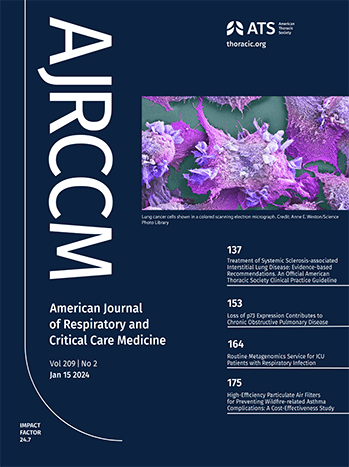以气道炎症测量和生物成像为指导的重症哮喘综合管理策略的临床缓解。
IF 19.4
1区 医学
Q1 CRITICAL CARE MEDICINE
American journal of respiratory and critical care medicine
Pub Date : 2025-06-20
DOI:10.1164/rccm.202412-2438oc
引用次数: 0
摘要
理由:临床缓解是重症哮喘的一个多组分治疗目标。然而,当使用嗜酸性粒细胞和FeNO水平来指导治疗决策时,只有约30%的患者达到临床缓解。目的:评估综合、个体化治疗策略在重度哮喘患者24个月内实现临床缓解的有效性。方法:治疗策略包括抗炎治疗、生物制剂、抗生素、免疫调节剂和支气管热成形术,以临床评估、气道生理学、气道炎症测量和生物成像为指导。临床缓解定义为24个月无恶化,不使用口服皮质类固醇(OCS),症状部分/良好控制,有或没有肺功能标准。测量和主要结果:对178例重度哮喘患者进行了评估。其中,88.2%的患者单独或联合使用生物制剂;20.2%接受抗生素、高渗盐水和/或免疫球蛋白治疗;9%的患者在控制炎症成分后行支气管热成形术。24个月后,89.9%的患者无加重,83.1%的患者无ocs, 78.1%的患者症状部分/良好控制,84.8%的患者肺功能保留。根据三个主要标准,66.3%的患者达到临床缓解,当包括FEV1%下降 ≤5%时,达到61.6%。然而,当采用最严格的标准(ACQ-5≤0.75,FEV1≥80%)时,临床缓解率为29.1%。残留疾病活动主要由气道感染和气道高反应性驱动,而不是T2炎症。结论:根据使用的定义,通过使用一套全面的生物标志物并采用针对个体病理生物学的管理策略,高比例的严重哮喘患者可以实现临床缓解。尽管如此,复发性气道感染、粘液和气道高反应性仍然是严重哮喘患者未满足的关键需求。本文章由计算机程序翻译,如有差异,请以英文原文为准。
Clinical Remission by a Comprehensive Severe Asthma Management Strategy Guided by Airway Inflammometry and Bioimaging.
Rationale: Clinical remission is a multicomponent treatment goal in severe asthma. However, only about 30% of patients achieve clinical remission when treatment decisions are guided using blood eosinophil and FeNO levels. Objectives: To assess the effectiveness of a comprehensive, individualized treatment strategy in achieving clinical remission over 24 months in patients with severe asthma. Methods: Treatment strategies-including anti-inflammatory therapies, biologics, antibiotics, immunomodulators, and bronchial thermoplasty-were guided by clinical assessment, airway physiology, airway inflammometry, and bioimaging. Clinical remission was defined as no exacerbations for 24 months, no oral corticosteroid (OCS) use, and partly/well-controlled symptoms, with or without lung function criteria. Measurements and Main Results: One-hundred seventy-eight patients with severe asthma were evaluated. Of these, 88.2% were treated with biologics alone or in combination with other strategies; 20.2% were treated with antibiotics, hypertonic saline, and/or immunoglobulins; and 9% underwent bronchial thermoplasty after controlling the inflammatory component. After 24 months, 89.9% of patients were exacerbation-free, 83.1% were OCS-free, 78.1% had partly/well-controlled symptoms, and 84.8% had preserved lung function. Clinical remission was achieved in 66.3% of patients based on the three primary criteria and in 61.6% when including FEV1% decline ≤5% from baseline. However, when the most stringent criteria were applied (ACQ-5 ≤0.75 and FEV1 ≥80%), the clinical remission rate was 29.1%. Residual disease activity was driven primarily by airway infections and airway hyperresponsiveness rather than T2 inflammation. Conclusions: By using a comprehensive set of biomarkers and employing a management strategy tailored to individual pathobiology, a high proportion of patients with severe asthma can achieve clinical remission, depending on the definitions used. Nonetheless, recurrent airway infections, mucus, and airway hyperresponsiveness remain key unmet needs in severe asthma.
求助全文
通过发布文献求助,成功后即可免费获取论文全文。
去求助
来源期刊
CiteScore
27.30
自引率
4.50%
发文量
1313
审稿时长
3-6 weeks
期刊介绍:
The American Journal of Respiratory and Critical Care Medicine focuses on human biology and disease, as well as animal studies that contribute to the understanding of pathophysiology and treatment of diseases that affect the respiratory system and critically ill patients. Papers that are solely or predominantly based in cell and molecular biology are published in the companion journal, the American Journal of Respiratory Cell and Molecular Biology. The Journal also seeks to publish clinical trials and outstanding review articles on areas of interest in several forms. The State-of-the-Art review is a treatise usually covering a broad field that brings bench research to the bedside. Shorter reviews are published as Critical Care Perspectives or Pulmonary Perspectives. These are generally focused on a more limited area and advance a concerted opinion about care for a specific process. Concise Clinical Reviews provide an evidence-based synthesis of the literature pertaining to topics of fundamental importance to the practice of pulmonary, critical care, and sleep medicine. Images providing advances or unusual contributions to the field are published as Images in Pulmonary, Critical Care, Sleep Medicine and the Sciences.
A recent trend and future direction of the Journal has been to include debates of a topical nature on issues of importance in pulmonary and critical care medicine and to the membership of the American Thoracic Society. Other recent changes have included encompassing works from the field of critical care medicine and the extension of the editorial governing of journal policy to colleagues outside of the United States of America. The focus and direction of the Journal is to establish an international forum for state-of-the-art respiratory and critical care medicine.

 求助内容:
求助内容: 应助结果提醒方式:
应助结果提醒方式:


